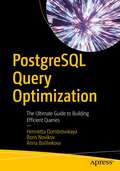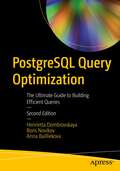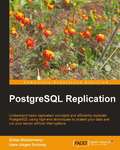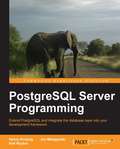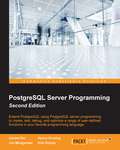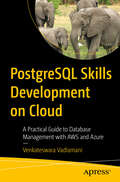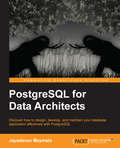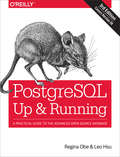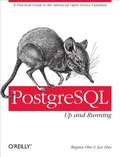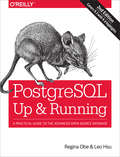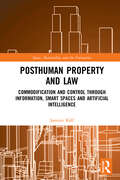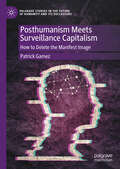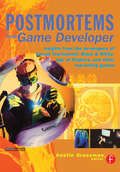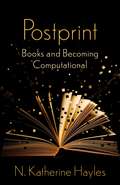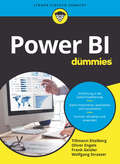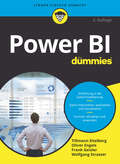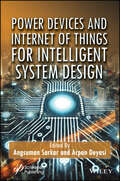- Table View
- List View
PostgreSQL Query Optimization: The Ultimate Guide to Building Efficient Queries
by Boris Novikov Henrietta Dombrovskaya Anna BailliekovaWrite optimized queries. This book helps you write queries that perform fast and deliver results on time. You will learn that query optimization is not a dark art practiced by a small, secretive cabal of sorcerers. Any motivated professional can learn to write efficient queries from the get-go and capably optimize existing queries. You will learn to look at the process of writing a query from the database engine’s point of view, and know how to think like the database optimizer. The book begins with a discussion of what a performant system is and progresses to measuring performance and setting performance goals. It introduces different classes of queries and optimization techniques suitable to each, such as the use of indexes and specific join algorithms. You will learn to read and understand query execution plans along with techniques for influencing those plans for better performance. The book also covers advanced topics such as the use of functions and procedures, dynamic SQL, and generated queries. All of these techniques are then used together to produce performant applications, avoiding the pitfalls of object-relational mappers. What You Will LearnIdentify optimization goals in OLTP and OLAP systemsRead and understand PostgreSQL execution plansDistinguish between short queries and long queriesChoose the right optimization technique for each query typeIdentify indexes that will improve query performanceOptimize full table scansAvoid the pitfalls of object-relational mapping systemsOptimize the entire application rather than just database queries Who This Book Is ForIT professionals working in PostgreSQL who want to develop performant and scalable applications, anyone whose job title contains the words “database developer” or “database administrator" or who is a backend developer charged with programming database calls, and system architects involved in the overall design of application systems running against a PostgreSQL database
PostgreSQL Query Optimization: The Ultimate Guide to Building Efficient Queries
by Boris Novikov Henrietta Dombrovskaya Anna BailliekovaWrite optimized queries. This book helps you write queries that perform fast and deliver results on time. You will learn that query optimization is not a dark art practiced by a small, secretive cabal of sorcerers. Any motivated professional can learn to write efficient queries from the get-go and capably optimize existing queries. You will learn to look at the process of writing a query from the database engine’s point of view, and know how to think like the database optimizer. The book begins with a discussion of what a performant system is and progresses to measuring performance and setting performance goals. It introduces different classes of queries and optimization techniques suitable to each, such as the use of indexes and specific join algorithms. You will learn to read and understand query execution plans along with techniques for influencing those plans for better performance. The book also covers advanced topics such as the use of functions and procedures, dynamic SQL, and generated queries. All of these techniques are then used together to produce performant applications, avoiding the pitfalls of object-relational mappers.This second edition includes new examples using Postgres 15 and the newest version of the PostgresAir database. It includes additional details and clarifications about advanced topics, and covers configuration parameters in greater depth. Finally, it makes use of advancements in NORM, using automatically generated functions. What You Will LearnIdentify optimization goals in OLTP and OLAP systemsRead and understand PostgreSQL execution plansDistinguish between short queries and long queriesChoose the right optimization technique for each query typeIdentify indexes that will improve query performanceOptimize full table scansAvoid the pitfalls of object-relational mapping systemsOptimize the entire application rather than just database queries Who This Book Is ForIT professionals working in PostgreSQL who want to develop performant and scalable applications, anyone whose job title contains the words “database developer” or “database administrator" or who is a backend developer charged with programming database calls, and system architects involved in the overall design of application systems running against a PostgreSQL database
PostgreSQL Replication
by Hans-Jurgen Schonig Zoltan BoszormenyiThis book has a chapter dedicated to each aspect of replication. The new features of PostgreSQL 9 are introduced and there are lots of practical examples and screenshots."PostgreSQL Replication" is ideal for PostgreSQL administrators who want to set up and understand replication. If you want to make your databases more robust, more secure, faster, and more scalable, you will find all the information you need in this single book focusing exclusively on PostgreSQL replication. It is assumed that you already have some basic experience with PostgreSQL.
PostgreSQL Server Programming
by Hannu Krosing Kirk Roybal Jim MlodgenskiThis practical guide leads you through numerous aspects of working with PostgreSQL. Step by step examples allow you to easily set up and extend PostgreSQL. "PostgreSQL Server Programming" is for moderate to advanced PostgreSQL database professionals. To get the best understanding of this book, you should have general experience in writing SQL, a basic idea of query tuning, and some coding experience in a language of your choice.
PostgreSQL Server Programming - Second Edition
by Usama Dar Hannu KrosingThis book is for moderate to advanced PostgreSQL database professionals who wish to extend PostgreSQL, utilizing the most updated features of PostgreSQL 9.4. For a better understanding of this book, familiarity with writing SQL, a basic idea of query tuning, and some coding experience in your preferred language is expected.
PostgreSQL Skills Development on Cloud: A Practical Guide to Database Management with AWS and Azure
by Venkateswara VadlamaniThis book provides a comprehensive approach to manage PostgreSQL cluster databases on Amazon Web Services and Azure Web Services on the cloud, as well as in Docker and container environments on a Red Hat operating system. Furthermore, detailed references for managing PostgreSQL on both Windows and Mac are provided. This book condenses all the fundamental and essential concepts you need to manage a PostgreSQL cluster into a one-stop guide that is perfect for newcomers to Postgres database administration. Each chapter of the book provides historical context and documents version changes of the PostgreSQL cluster, elucidates practical "how-to" methods, and includes illustrations and key word definitions, practices for application, a summary of key learnings, and questions to reinforce understanding. The book also outlines a clear study objective with a weekly learning schedule and hundreds of practice exercises, along with questions and answers. With its comprehensive and practical approach, this book will help you gain the confidence to manage all aspects of a PostgreSQL cluster in critical production environments so you can better support your organization's database infrastructure on the cloud and in containers. What You Will Learn Install and configure Postgres clusters on the cloud and in containers, monitor database logs, start and stop databases, troubleshoot, tune performance, backup and recover, and integrate with Amazon S3 and Azure Data Blob Manage Postgres databases on Amazon Web Services and Azure Web Services on the cloud, as well as in Docker and container environments on a Red Hat operating system Access sample references to scripting solutions and database management tools for working with Postgres, Redshift (based on Postgres 8.2), and Docker Create Amazon Machine Images (AMI) and Azure Images for managing a fleet of Postgres clusters on the cloud Reinforce knowledge with a weekly learning schedule and hundreds of practice exercises, along with questions and answers Progress from simple concepts, such as how to choose the correct instance type, to creating complex machine images Gain access to an Amazon AMI with a DBA admin tool, allowing you to learn Postgres, Redshift, and Docker in a cloud environment Refer to a comprehensive summary of documentations of Postgres, Amazon Web services, Azure Web services, and Red Hat Linux for managing all aspects of Postgres cluster management on the cloud Who This Book Is For Newcomers to PostgreSQL database administration and cross-platform support DBAs looking to master PostgreSQL on the cloud.
PostgreSQL for Data Architects
by Jayadevan MaymalaThis book is for developers and data architects who have some exposure to databases. It is assumed that you understand the basic concepts of tables and common database objects, including privileges and security.
PostgreSQL: A Practical Guide to the Advanced Open Source Database
by Regina O. Obe Leo S. HsuThinking of migrating to PostgreSQL? This clear, fast-paced introduction helps you understand and use this open source database system. Not only will you learn about the enterprise class features in versions 9.5 to 10, youâ??ll also discover that PostgeSQL is more than a database systemâ??itâ??s an impressive application platform as well.With examples throughout, this book shows you how to achieve tasks that are difficult or impossible in other databases. This third edition covers new features, such as ANSI-SQL constructs found only in proprietary databases until now: foreign data wrapper (FDW) enhancements; new full text functions and operator syntax introduced in version 9.6; XML constructs new in version 10; query parallelization features introduced in 9.6 and enhanced in 10; built-in logical replication introduced in Version 10.e.If youâ??re a current PostgreSQL user, youâ??ll pick up gems you may have missed before.Learn basic administration tasks such as role management, database creation, backup, and restoreApply the psql command-line utility and the pgAdmin graphical administration toolExplore PostgreSQL tables, constraints, and indexesLearn powerful SQL constructs not generally found in other databasesUse several different languages to write database functionsTune your queries to run as fast as your hardware will allowQuery external and variegated data sources with foreign data wrappersLearn how to use built-in replication to replicate data
PostgreSQL: Up and Running
by Regina Obe Leo HsuIf you're thinking about migrating to the PostgreSQL open source database system, this guide provides a concise overview to help you quickly understand and use PostgreSQL's unique features. Not only will you learn about the enterprise class features in the 9.2 release, you'll also discover that PostgeSQL is more than just a database system--it's also an impressive application platform. With numerous examples throughout this book, you'll learn how to achieve tasks that are difficult or impossible in other databases. If you're an existing PostgreSQL user, you'll pick up gems you may have missed along the way. Learn basic administration tasks, such as role management, database creation, backup, and restore Apply the psql command-line utility and the pgAdmin graphical administration tool Explore PostgreSQL tables, constraints, and indexes Learn powerful SQL constructs not generally found in other databases Use several different languages to write database functions Tune your queries to run as fast as your hardware will allow Query external and variegated data sources with Foreign Data Wrappers Learn how to replicate data, using built-in replication features
PostgreSQL: Up and Running
by Regina O. Obe Leo S. HsuThinking of migrating to PostgreSQL? This clear, fast-paced introduction helps you understand and use this open source database system. Not only will you learn about the enterprise class features in versions 9.2, 9.3, and 9.4, you'll also discover that PostgeSQL is more than a database system--it's also an impressive application platform.With examples throughout, this book shows you how to achieve tasks that are difficult or impossible in other databases. This second edition covers LATERAL queries, augmented JSON support, materialized views, and other key topics. If you're a current PostgreSQL user, you'll pick up gems you may have missed before.Learn basic administration tasks such as role management, database creation, backup, and restoreApply the psql command-line utility and the pgAdmin graphical administration toolExplore PostgreSQL tables, constraints, and indexesLearn powerful SQL constructs not generally found in other databasesUse several different languages to write database functionsTune your queries to run as fast as your hardware will allowQuery external and variegated data sources with foreign data wrappersLearn how use built-in replication filters to replicate data
Posthuman Gaming: Avatars, Gamers, and Entangled Subjectivities (Routledge Advances in Game Studies)
by Poppy WildePosthuman Gaming: Avatars, Gamers, and Entangled Subjectivities explores the relationship between avatar and gamer in the massively multiplayer online roleplaying game World of Warcraft, to examine notions of entangled subjectivity, affects and embodiments – what it means and how it feels to be posthuman. With a focus on posthuman subjectivity, Wilde considers how we can begin to articulate ourselves when the boundary between self and other is unclear. Drawing on fieldnotes of her own gameplay experiences, the author analyses how subjectivity is formed in ways that defy a single individual notion of "self", and explores how different practices, feelings, and societal understandings can disrupt strict binaries and emphasise our posthumanism. She interrogates if one can speak of an "I" in the face of posthuman multiplicity, before exploring different analytical themes, beginning with how acting theories might be posthumanised and articulate the relationship between avatar and gamer. She then defines posthuman empathy and explains how this is experienced in gaming, before addressing the need to account for boredom, the complexity of nostalgia, and ways death and loss are experienced through gaming. This volume will appeal to a broad audience and is particularly relevant to scholars and students of cultural studies, media studies, humanities, and game studies. Chapters 2 and 7 of this book are freely available as a downloadable Open Access PDF at http://www.taylorfrancis.com under a Creative Commons Attribution-Non Commercial-No Derivatives (CC-BY-NC-ND) 4.0 license.
Posthuman Property and Law: Commodification and Control through Information, Smart Spaces and Artificial Intelligence
by Jannice KällThis book analyses the phenomenon of digitally mediated property and considers how it problematises the boundary between human and nonhuman actors. The book addresses the increasingly porous border between personhood and property in digitized settings and considers how the increased commodification of knowledge makes visible a rupture in the liberal concept of the property owning, free, person. Engaging with the latest work in posthumanist and new materialist theory, it shows, how property as a concept as well as a means for control, changes fundamentally under advanced capitalism. Such change is exemplified by the way in which data, as an object of commodification, is extracted from human activities yet is also directly used to affectively control – or nudge – humans. Taking up a range of human engagements with digital platforms and coded architectures, as well as the circulation of affects through practices of artificial intelligence that are employed to shape behaviour, the book argues that property now needs to be understood according to an ecology of human as well as nonhuman actors. The idea of posthuman property, then, offers both a means to critique property control through digital technologies, as well as to move beyond the notion of the self-owning, object-owning, human. Engaging the most challenging contemporary technological developments, this book will appeal to researchers in the areas of Law and Technology, Legal Theory, Intellectual Property Law, Legal Philosophy, Sociology of Law, Sociology, and Media Studies.
Posthuman Research Practices in Education
by Carol A. Taylor Christina HughesHow do we include and develop understandings of those beyond-the-human aspects of the world in social research? Through fifteen contributions from leading international thinkers, this book provides original approaches to posthumanist research practices in education. It responds to questions which consider the effect and reach of posthuman research.
Posthumanism Meets Surveillance Capitalism: How to Delete the Manifest Image (Palgrave Studies in the Future of Humanity and its Successors)
by Patrick GamezThe core contention of this book is that, when viewed through the lens of contemporary posthuman theory, contemporary uses of AI under platform capitalism not only undermine our sense of the &“human&” but also our frameworks for conceptualizing ourselves as &“subjects&” or &“selves&” at all. This radical conclusion raises issues forces us to reckon with a new, disorienting horizon for critical thought at the intersection of technology and politics. This book demonstrates that two major streams of posthuman thought—namely, accelerationism and Prometheanism—can be interpreted as attempts to liberate our desires from our reason or our rationality from our all-too-human desire, each through the offloading of various tasks to emerging technologies. But, Patrick Gamez argues, the rise of opaque, unexplainable machine learning algorithms to predict and shape our behaviour undermines the common-sense models of mind through which we ultimately make sense of both the human and the posthuman.
Postinternet Art and Its Afterlives (Routledge Advances in Art and Visual Studies)
by Ian RothwellFocusing on the ‘postinternet’ art of the 2010s, this volume explores the widespread impact of recent internet culture on the formal and conceptual concerns of contemporary art. The ‘postinternet’ art movement is splintered and loosely defined, both in terms of its form and its politics, and has come under significant critique for this reason. This study will provide this definition, offering a much-needed critical context for this period of artistic activity that has had and is still having a major impact on contemporary culture. The book presents a picture of what the art and culture made within and against the constraints of the online experience look, sound, and feel like. It includes works by Petra Cortright, Jon Rafman, Jordan Wolfson, DIS, Amalia Ulman, and Thomas Ruff, and presents new analyses of case studies drawn from the online worlds of the 2010s, including vaporwave, anonymous image board culture, ‘irony bros’ and ‘edgelords’, viral extreme sports stunts, and GIFs. The book will be of interest to scholars working in art history, contemporary art, and digital culture.
Postmortems from Game Developer: Insights from the Developers of Unreal Tournament, Black & White, Age of Empire, and Other Top-Selling Games
by Austin GrossmanThe popular Postmortem column in Game Developer magazine features firsthand accounts of how some of the most important and successful games of recent years have been made. This book offers the opportunity to harvest this expertise with one volume. The editor has organized the articles by theme and added previously unpublished analysis to reveal successful management techniques. Readers learn how superstars of the game industry like Peter Molyneux and Warren Spector have dealt with the development challenges such as managing complexity, software and game design issues, schedule challenges, and changing staff needs.
Postprint: Books and Becoming Computational (The Wellek Library Lectures #109)
by N. Katherine HaylesSince Gutenberg’s time, every aspect of print has gradually changed. But the advent of computational media has exponentially increased the pace, transforming how books are composed, designed, edited, typeset, distributed, sold, and read. N. Katherine Hayles traces the emergence of what she identifies as the postprint condition, exploring how the interweaving of print and digital technologies has changed not only books but also language, authorship, and what it means to be human.Hayles considers the ways in which print has been enmeshed in literate societies and how these are changing as some of the cognitive tasks once performed exclusively by humans are now carried out by computational media. Interpretations and meaning-making practices circulate through transindividual collectivities created by interconnections between humans and computational media, which Hayles calls cognitive assemblages. Her theoretical framework conceptualizes innovations in print technology as redistributions of cognitive capabilities between humans and machines. Humanity is becoming computational, just as computational systems are edging toward processes once thought of as distinctively human. Books in all their diversity are also in the process of becoming computational, representing a crucial site of ongoing cognitive transformations.Hayles details the consequences for the humanities through interviews with scholars and university press professionals and considers the cultural implications in readings of two novels, The Silent History and The Word Exchange, that explore the postprint condition. Spanning fields including book studies, cultural theory, and media archeology, Postprint is a strikingly original consideration of the role of computational media in the ongoing evolution of humanity.
Postsecondary Play: The Role of Games and Social Media in Higher Education (Tech.edu: A Hopkins Series on Education and Technology)
by William G. Tierney, Zoë B. Corwin, Tracy Fullerton and Gisele RagusaGames and social media can improve college access, attract and support students, and boost rates of completion.The college application process—which entails multiple forms, essays, test scores, and deadlines—can be intimidating. For students without substantial school and family support, the complexity of this process can become a barrier to access. William G. Tierney, Tracy Fullerton, and their teams at the University of Southern California approach this challenge innovatively. Using the tools of online games and social media, they have developed ways to make applying for college much less intimidating.While the vast majority of college students use social media and gaming in their everyday lives, colleges and universities have been slow to recognize and harness the power of either. Postsecondary Play explores the significance of games and social media in higher education, and particularly how they can be used to attract, retain, educate, and socialize students.Tierney, a past president of the American Educational Research Association, has gathered some of the best research on the emerging role of games and social media in the classroom and how these tools can boost student confidence and increase college access. Scholars writing from a wide variety of disciplines—college access, social media, game studies, and learning sciences—provide concrete examples to illustrate the new and complex ways in which students learn in response to social media and games. Tierney and the contributors find that, although games can be powerful tools for encouraging underserved students, quality game design and mastering the concept of play—the ability to develop skills while engaging in the game—are essential in the effective use of serious games in teaching and learning.Summarizing a decade of research in game design and learning, Postsecondary Play will appeal to higher education scholars and students of learning, online gaming, education, and the media.
Potentialtheorie (Grundlagen der Physikalischen und Mathematischen Geodäsie)
by Karl Heinz IlkDieses Lehrbuch aus der Reihe „Grundlagen der Physikalischen und Mathematischen Geodäsie“ behandelt die für die Physikalische Geodäsie wichtigen Elemente der Potentialtheorie. Es führt in die feldtheoretischen Aspekte des Gravitationsfeldes ein und erklärt die wichtigen Grundlagen für die Lösung der geodätischen Randwertaufgaben. Der Autor erläutert ausführlich die Darstellung der verschiedenen Gravitationsfeldfunktionale durch Kugelfunktionen sowie die Transformationseigenschaften bei Translation und Drehung des zugrundeliegenden Koordinatensystems. Verschiedene Aspekte der Kugelfunktionen werden außerdem vertieft betrachtet, insbesondere die Darstellungen von Gravitationsfeldwechselwirkungen ausgedehnter Massenanordnungen, also Drehmomente, Gravitationstensor, Gezeitenpotential und vieles mehr.
Potion of the Turtle Master: An Unofficial Minecrafters Novel (Aquatic Adventures in the Overworld #4)
by Maggie MarksWhen sea turtles are trapped in an underwater cave, Mason and Luna are determined to get them out. Asher wants to use TNT to blast a tunnel, but Luna insists that mining slowly is safer. Then the guardians show up, claiming the cave as their own. Now the turtles aren’t the only ones in danger! Can Mason find a way to save himself from the deadly sea creatures, too? Find out more in this incredible fourth book of Aquatic Adventures in the Overworld: Potion of the Turtle Master! <p> Brothers Mason and Asher are learning how to cope with life outside the Overworld after a terrifying shipwreck that left them stranded underwater. Teamed up with their new friend Luna, this unlikely trio must make the choice of staying in the world they know best and risk death, or voyaging into an unknown world where anything could happen. In each story of the series for Minecrafters, follow their journey as Mason, Asher, and Luna face incredible obstacles and discover strength they never knew they had in Aquatic Adventures in the Overworld.
Power BI für Dummies (Für Dummies)
by Frank Geisler Tillmann Eitelberg Oliver Engels Wolfgang StrasserSie möchten, was Datenanalyse angeht, noch eine Schippe drauflegen? Dann steigen Sie auf die Microsoft Self Service BI Lösung "Power BI" um. Dieses Buch zeigt Ihnen die unzähligen Möglichkeiten, die Power BI bietet, um Ihre Daten aufzubereiten und ansprechend zu präsentieren. Zunächst lernen Sie die notwendigen Grundlagen kennen, um danach tief in die Welt der Datenauswertungen, DAX-Formeln, Power BI Data Flows, Custom Visuals, Dashboards und vielem mehr abzutauchen. Sie benötigen dazu keine großen IT-Kenntnisse - Erfahrung mit Excel reicht vollkommen aus. Mithilfe von vielen Praxisbeispielen lernen Sie schnell, sowohl mit dem Power BI Desktop Client als auch mit dem Power BI Cloud Service zu arbeiten.
Power BI für Dummies (Für Dummies)
by Frank Geisler Tillmann Eitelberg Oliver Engels Wolfgang StrasserSie möchten, was Datenanalyse angeht, noch eine Schippe drauflegen? Dann steigen Sie auf die Microsoft-Self-Service-BI-Lösung "Power BI" um. Dieses Buch zeigt Ihnen die unzähligen Möglichkeiten, die Power BI bietet, um Ihre Daten aufzubereiten und ansprechend zu präsentieren. Zunächst lernen Sie die notwendigen Grundlagen kennen, um danach tief in die Welt der Datenauswertungen, DAX-Formeln, Power BI Data Flows, Custom Visuals, Dashboards und vielem mehr abzutauchen. Sie benötigen dazu keine großen IT-Kenntnisse - Erfahrung mit Excel reicht vollkommen aus. Mithilfe von vielen Praxisbeispielen lernen Sie schnell, sowohl mit dem Power BI Desktop Client als auch mit dem Power BI Cloud Service zu arbeiten.
Power Composition for Photography
by Tom GallovichIn this book, Tom Gallovich shows readers how to use their camera's exposure controls (aperture, shutter speed, ISO) to establish the focal point of the image and create the overall mood of the shot and choose a particular lens or focal-length setting to massage the way elements in the original scene will appear within the frame. Next, he presents chapters on using shape, color, lines, and arrangement to strengthen the intended visual message. Readers will learn how to best place their primary subject (and in some cases secondary subject) for maximum impact and will discover artistic strategies that reinforce that decision through careful use of color, tone, highlight and shadow, leading lines, curved shapes, and relative size-qualities that will contribute to the overall mood in the image. Copious illustrations emphasize the impact that putting these concepts into play will have on your images-and these are often coupled with images that show how ineffective images are when those important compositional needs are not attended to.
Power Devices and Internet of Things for Intelligent System Design
by Arpan Deyasi Angsuman SarkarUnlock the potential of cutting-edge advancements in power electronics and IoT with Power Devices and Internet of Things for Intelligent System Design, a vital resource that bridges the gap between industry and academia, inspiring innovative solutions across diverse fields such as agriculture, healthcare, and security. This book explores the latest technological advancements in electrical circuits, particularly in the power electronics sector and IoT-based smart systems. The outcomes are closely aligned with current industrial applications, spanning from DC to higher-frequency spectrums. Research progress in electrical systems not only enhances power electronics and fault tolerance but also extends to internet-based surveillance systems designed to address emerging threats and develop mitigation strategies. Modern IoT-based system design incorporates numerous human-centered benefits, with the integration of blockchain architecture adding an interdisciplinary dimension to the research. The primary goal of this book is to leverage IoT and power engineering technologies to develop practical solutions to contemporary challenges while exploring the diverse applications of the Internet of Things across fields such as agriculture, home security, data protection, construction, healthcare, wildlife monitoring, cryptology, and employment in the hospitality sector. Power Devices and Internet of Things for Intelligent System Design serves as a critical link between industry and academia, a role that underscores the success of this endeavor.
Power Engineering and Intelligent Systems: Proceedings of PEIS 2023, Volume 1 (Lecture Notes in Electrical Engineering #1097)
by Jagdish Chand Bansal B. K. Panigrahi Vivek ShrivastavaThe book presents a collection of the high-quality research articles in the field of power engineering, grid integration, energy management, soft computing, artificial intelligence, signal and image processing, data science techniques, and their real-world applications. The papers are presented at International Conference on Power Engineering and Intelligent Systems (PEIS 2023), held during June 24–25, 2023, at National Institute of Technology Delhi, India.
